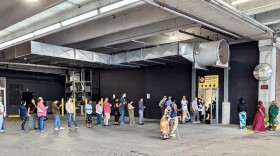November elections get all the glory.
But this year more than half of the state races in Kentucky will be decided by the end of the primary election.
For some candidates, filing their paperwork to run has essentially secured them their office because no one else filed to run against them. In 20 races, the candidate who wins the primary will not face an opponent in the general election, meaning they’ll basically get the job.
Last year, however, only 14.5% of Kentucky’s registered voters cast a ballot in the primary.
Local, state and federal leaders are responsible for making decisions that directly impact people’s daily lives. We know Kentuckians care about the direction their state is headed and are eager to learn more about their elected leaders.
So we created a free, interactive voter guide to help Kentucky voters get informed about the candidates they’ll see on their ballots in May.
In-person, excused absentee voting happens on May 8, 9, 10, and May 13, 14 and 15.
Early in-person, no excuse absentee voting will take place on May 16, 17 and 18.
You can visit the State Board of Elections website to learn where and when that takes place.
What’s in it?
The 2024 Voter Guide from Kentucky Public Radio includes the names, party affiliation, district and other official election information for every candidate you’ll see on your ballot.
Instead of committing to collecting and verifying an exhaustive list of candidate endorsements, we chose five well known organizations that advocate for issues and policies across political ideologies, including: Kentucky Right to Life, AFL-CIO, Fairness Campaign, Kentucky Chamber of Commerce, and the Sierra Club. We got endorsements directly from the organizations in an effort to give voters a snapshot of who got support from major political groups.
When you enter your address into the voter guide, it will display the candidates who you will see on your ballot, based on the district you’re in for state and national elections. People who reside in Louisville will also see the contested Metro Council races that will appear on their ballot.
How did we decide what to include?
We committed to reporting out candidate information on all the contested primary races. There are many races in which only one candidate is running. We chose not to invest our resources in those races because voters will not have the opportunity to decide between candidates. We plan to elucidate on all candidates in our voter guide for the general election.
There is only one municipal election that we dedicated resources to cover: Louisville Metro Council races. Thirteen Metro Council seats are up for grabs in the general election this year, and some districts have very competitive primaries.
We divided the candidates across reporters at LPM in Louisville, WKMS in Murray, WEKU in Richmond and WKYU in Bowling Green. It was their job to reach out to the candidate to invite them to participate in the voter guide process. We built a Google form that candidates could use to give us biographical information and tell us about their top political priorities. We reached out to each candidate at least three ways: by mail, by phone and by email.
After the participation deadline passed, reporters reviewed the candidate entries. For candidates who participated, they reviewed the information and fact-checked it. For candidates who did not participate, reporters researched their background and what they have said publicly about their priorities in office, including on their campaign websites, social media and taped interviews. In some cases, we couldn’t find verifiable information on the candidate, and that is noted in the voter guide.
Editors reviewed more than 180 candidate entries over multiple rounds of edits. Then, we brought in our data reporter to build the tool itself.
How did you build it?
A lot of complicated processes go on underneath each election. In this primary, there are at least five different geographic boundaries that determine which candidates you can vote for: your U.S. House district, Kentucky Senate district, Kentucky House district, Kentucky Supreme Court district and your county – for the purpose of electing a commonwealth attorney. Then, if you’re in Louisville, there’s also Metro Council districts.
Underlying this voter guide is some code that takes your address and compares it to six different maps in a matter of milliseconds. It finds which districts are applicable to you. The code then cross-references your districts with the information our reporters collected on each candidate. And then – voila! – it displays just the candidates and information you need to know about.
Finally, each candidate has a checkbox under their name. You can click on it to “select” the candidate you want to vote for. Then, when you get to the bottom of the page, you can get a simplified “cheat sheet” to take to your ballot box that shows you just who you want to vote for.
Sylvia Goodman contributed to this reporting.








